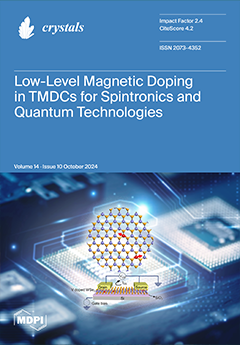Clays have been exploited in the manufacture of diverse products from ceramics to paints, pharmaceuticals, plastics, cosmetics, and more. Thus, they can be used in many industrial applications, showing good adsorbent ability thanks to their lamellar structure, high cation exchange capacity, pore size
[...] Read more.
Clays have been exploited in the manufacture of diverse products from ceramics to paints, pharmaceuticals, plastics, cosmetics, and more. Thus, they can be used in many industrial applications, showing good adsorbent ability thanks to their lamellar structure, high cation exchange capacity, pore size distribution, and large surface area. For this reason, considerable attention has been paid to their in-depth characterization, for further integration in sectors such as biomedicine, construction, remediation, aerospace, and nanotechnology. For this aim, two samples of natural clays, ALO1 and PRE4, from the southeast part of Albania, were subject to a multi-methodological characterization, with the aim of addressing the use of such geomaterials in possible sensing applications. X-ray fluorescence analysis, morphological characterization of the samples, and energy-dispersive system spectroscopy pointed to an extreme mineralogical variety, with kaolinite in AL01 and montmorillonite in PRE4 as the most abundant phases. This fact was further confirmed by powder X-ray diffraction, showing a quartz content of 20%, a kaolinite content of 64%, and a muscovite content of 16% for ALO1; meanwhile, for PRE4, we found a content of quartz of 45%, a content of montmorillonite of 34.9%, and a content of clinochlore of 20%. Infrared spectroscopy and thermal analyses confirmed the presence of hydroxyl groups in both samples, suggesting a higher content in ALO1. Measurement of N
2 adsorption isotherms on the clay samples yields specific surface areas of 87 m
2/g for PRE4 and 32 m
2/g for ALO1, pore volumes of 0.721 cm
3/g for PRE4 and 0.637 cm
3/g for ALO1, and similar pore sizes in the range of 6–12 nm. Electrochemical analysis highlighted a good conductivity of ALO1 and PRE4 when used for the modification of commercial carbon-based screen-printed electrodes. In detail, higher currents were registered by differential pulse voltammetry for the electrodes modified with the clays with respect to bare electrodes, as well as good repeatability of the measurements. In addition, a comparative study with nanomaterials, known for their good conductivity, was achieved, using carbon black and gold nanoparticles as a reference, showing that the conductivity of the clays was lower than but not so different from those of the reference materials.
Full article





